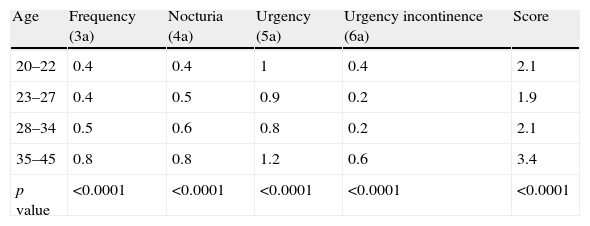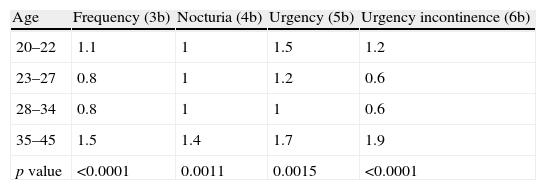Overactive bladder syndrome (OAB) is defined by the ICS (International Continence Society) as urinary urgency, with or without urgency incontinence and frequently associated with increase of frequency and nocturia.
PurposeThe aim of the study was to establish a correlation between OAB symptoms and age in women aged 20–45.
Materials/methodsWe interviewed 1050 women aged 20–45 in the area of Campinas, Brazil, to investigate the prevalence of overactive bladder symptoms. In this study we used the ICIQ-OAB questionnaire (ICS standard), in its validated Portuguese version and a specific questionnaire for the demographics.
ResultsOverall, women aged 35–45 years showed significantly higher scores in the ICIQ-OAB questionnaire than all other groups. (p<0.001). Older women (35–45) presented a significantly higher score than younger women (all other groups) (p<0.0001) regarding urinary frequency. Regarding frequency, there was a significant difference between the age group 35–45 (higher score) and the age groups 20–22 and 23–27 (p<0.0001). Women aged 35–45 presented significantly more nocturia than women in the age groups of 28–34, 23–27 and 20–22. Women in the group of 28–34 also presented more nocturia than women aged 20–22 (p<0.0001). Women aged 35–45 experienced more urgency than those in the age groups of 28–34 and 23–27 (p<0.0001). Women aged 35–45 had significantly more urgency incontinence than all the other groups, and women in group of 20–22 also presented more incontinence than those aged 23–27 (p<0.0001). Significant differences were also found regarding symptom bother, women in group 35–45 years old presented higher scores than the other groups regarding frequency (p<0.0001), nocturia (p=0.0011), urgency (p=0.0015) and urgency incontinence (p<0.0001).
ConclusionsIn conclusion, older women present more OAB symptoms and therefore a higher score than younger women had.
El Síndrome de Vejiga Hiperactiva (SVH) está definido por la SIC (Sociedad Internacional de Continencia) como urgencia urinaria, con o sin incontinencia de urgencia y con frecuencia asociado con un aumento de la frecuencia y de la nicturia.
PropósitoEl objetivo del estudio fue establecer una correlación entre los síntomas de SVH y la edad en mujeres de entre 20 y 45 años.
Materiales/MétodosEntrevistamos a 1050 mujeres de entre 20 y 45 años en el área de Campinas, Brasil, para investigar la prevalencia de Síntomas de Vejiga Hiperactiva. En este estudio utilizamos el cuestionario ICIQ-SVH (Estándar de la SIC), en su versión portuguesa validada y un cuestionario específico para la demografía.
ResultadosEn general, las mujeres de 35-45 años mostraron puntuaciones significativamente más altas en el cuestionario ICIQ-SVH que todos los demás grupos. (p<0,001). Las mujeres mayores (35-45) presentaron una puntuación significativamente más alta que las mujeres más jóvenes (todos los demás grupos) (p<0,0001) con respecto a la frecuencia urinaria. En cuanto a la frecuencia, hubo una diferencia significativa entre el grupo de edad 35-45 (mayor puntuación) y los grupos de edad 20-22 y 23-27 (p<0,0001). Las mujeres de 35-45 presentaron significativamente más nicturia que las mujeres en los grupos de edad de 28-34, 23-27 y 20-22. Las mujeres en el grupo de 28-34 también presentaron más nicturia que las mujeres de edades comprendidas entre los 20 y los 22 (p<0,0001). Las mujeres de 35-45 experimentaron más urgencia que las de los grupos de edad de 28-34 y 23-27 (p<0,0001). Las mujeres de 35-45 tuvieron significativamente más incontinencia de urgencia que todos los demás grupos y las mujeres en el grupo de 20-22 también presentaron más incontinencia que las de 23-27 (p<0,0001). También se encontraron diferencias significativas en cuanto a la molestia de los síntomas, las mujeres en el grupo de 35-45 años de edad presentaron puntuaciones más altas que los demás grupos con respecto a la frecuencia (p<0,0001), nicturia (p=0,0011), urgencia (p=0,0015) e incontinencia de urgencia (p<0,0001).
ConclusionesEn conclusión, las mujeres mayores presentan más síntomas de SVH y, por lo tanto, una puntuación mayor que las mujeres más jóvenes.











